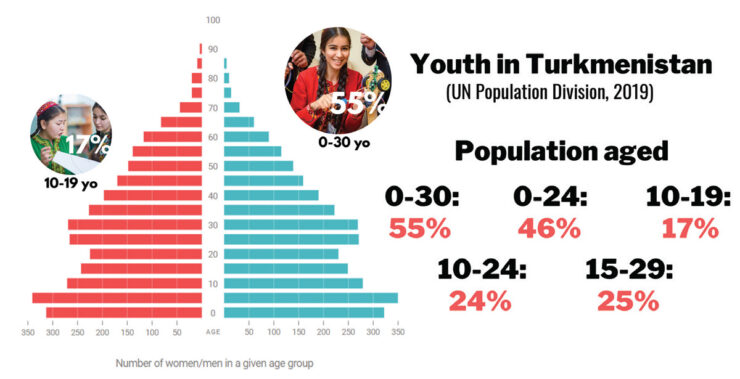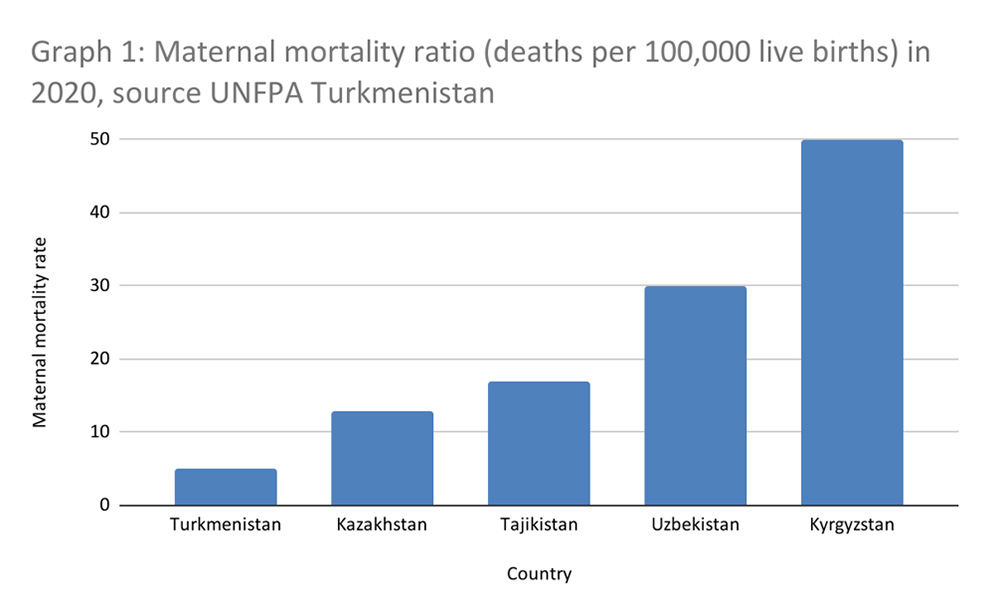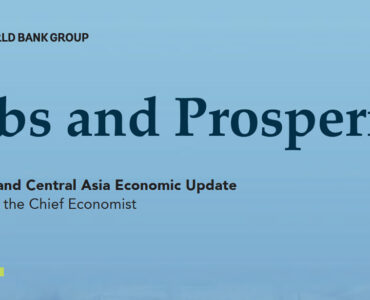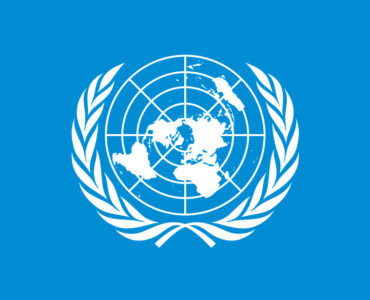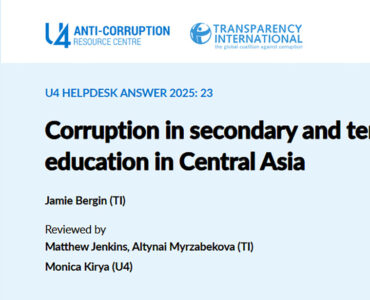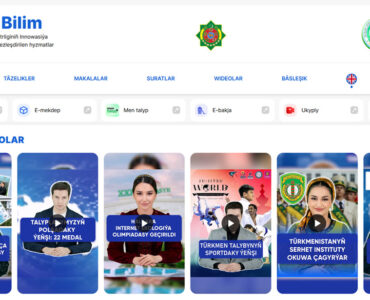This is the second article of the two on adolescent pregnancy that addresses the effects of adolescent pregnancy in Turkmenistan. In our first article we covered the causes and consequences of adolescent pregnancy, and steps the government of Turkmenistan undertook to reduce adolescent pregnancy in the country.
Adolescent pregnancy poses a critical global concern, and so is the case with Turkmenistan where many girls face inadequate healthcare access that exacerbates health risks for both young mothers and their infants. Additionally, adolescent pregnancy has far-reaching social and economic consequences, limiting educational and career opportunities, perpetuating gender inequality, and increasing the risk of violence due to traditional gender norms.
Adolescent pregnancy remains a major contributor to maternal and child mortality and complications relating to pregnancy and childbirth are the leading cause of death for girls aged 15-19 globally. In Turkmenistan, every year, 5 women aged 15–49 years die per 100,000 live births due to pregnancy-related causes (Graph 1).
And while this is the lowest indicator in Central Asia, according to UNICEF data, child mortality across different early child ages is highest in Turkmenistan: out of 1,000 children 39 die before reaching the age of 1 and 46 die before reaching the age 5. Due to lack of data to understand the proportion of child mortality for mothers below 20 years old in MICS 2019, we do not have a full picture of the issue on adolescent pregnancy and child mortality in the country.
Pregnant girls and adolescents also face other health risks and complications due to their immature bodies. Adolescents are exposed to higher risks of eclampsia, puerperal endometritis and systemic infections than women aged 20–24 years, and babies of adolescent mothers face higher risks of low birth weight, preterm birth and severe neonatal condition, as well as other health and development complications. In addition, based on Guttmacher data, every year in Turkmenistan 130 pregnant girls make fewer than four antenatal care visits and 69 do not deliver in a health facility.
Access to abortion care
According to Plan International, 3.9 million unsafe abortions occur each year to girls aged 15-19 in developing regions. In Turkmenistan, of all unintended pregnancies, 83% end up in abortion. But since many unsafe abortions go unreported, there is no record of how many young girls aged 15-19 opt to unsafe abortions, or abortions per se. Data on abortions is limited in Turkmenistan and is not disaggregated. Yet, with the new restrictions, chances for young girls to choose unsafe abortions may only increase, putting at risk their health and lives.
Adolescent pregnancy can also have negative social and economic effects on girls, their families and communities, as it puts girls behind very early on, starting from pursuing education and later to professional opportunities. In existing socio-economic dynamics, women are already behind educational and employment pursuits. Less women (42.5%) get higher education in Turkmenistan than men and half of the female population remain unemployed compared to 26% of unemployed men. In addition, ILO indicates women with children are less likely to engage in employment than men with children. In Europe and Central Asia women with children work less (59%) than men with children (77%). This means that adolescent pregnancy becomes an additional barrier in the lives of girls in Turkmenistan that can increase inequity and lead to a cycle of poverty and a vulnerable position of dependence.
Unmarried pregnant adolescents may face stigma or rejection by parents and peers as well as threats of violence due to societal beliefs. Girls who become pregnant before age 18 are more likely to experience violence within a marriage or partnership. According to MICS 2019, around 56% of girls in Turkmenistan aged 15-19 justify violence against women due to established traditional gender roles in the family and society. The percentage is even higher among women aged 20-24, reaching up to 61.8%. Currently, there is no data on how many girls are subjected to child sexual abuse and as a result face increased risks of pregnancy, often unintended in Turkmenistan.
Donate to support Turkmen analysts, researchers and writers to produce factual, constructive and progressive content in their efforts to educate the public of Turkmenistan.
SUPPORT OUR WORKRecommendations
The government of Turkmenistan has undertaken some steps towards reducing adolescent pregnancy and set up future steps in achieving it. Yet, there is a substantial amount of work that needs to be accomplished in order to create a sustainable and protected environment for girls’ rights and well-being.
We at Saglyk and Progres provide a space for Turkmen-speaking young women and men to access science-based sex education in their language. We have developed comprehensive content concerning women’s health, access to abortion, contraception, family planning, and child mortality and its causes. We also launched BIL’IM (can mean either “period” or “knowledge”, depending on which syllable you emphasize in Turkmen) app that is the first mobile period tracker app with content on women’s and girls’ health and rights in Turkmenistan. Finally, Saglyk has developed 100 answers to 100 questions on sexuality and reproductive health that Turkmen teens are too ashamed to ask their parents and teachers.
We invite the government to collaborate with us and use the existing content for the benefit of adolescents in Turkmenistan as we believe in the importance and value of information and knowledge and incorporate it in its Basic Life Skills program.
Saglyk’s recommendations to the government for immediate action:
- Ensure participation of adolescents in the development, implementation, and evaluation of laws, policies, programs, and projects that involve them or address issues relating to them. Public participation is a core human rights principle.
- Taskforce and research: Сreate a taskforce to study and research the issues to set the agenda. The taskforce should include representatives of civil society, experts and researchers on youth issues, doctors, parents and teachers.
- Comprehensive sexuality education: Design and Implement comprehensive sex education programs in schools that cover topics such as sexual and reproductive health, contraception, gender equality, and the consequences of early pregnancy. Ensure that these programs are science-based, age-appropriate and include practical information on accessing contraception.
- Access to contraceptives: Improve access to contraceptives, particularly in rural areas and among economically disadvantaged populations. Ensure that adolescents are aware of and have easy access to a variety of contraceptive methods free of charge.
- Eliminate prior parental consent for adolescents to access contraceptives. As per International human rights standards including the Committee on the Rights of the Child call governments to consider adopting a legal presumption stating that adolescents are competent to seek and have access to sexual and reproductive health commodities and services, including abortion. (CRC General Comment 20).
- Youth-friendly services: Continue to expand and strengthen youth-friendly healthcare services, as mentioned in the National Strategy on Reproductive, Maternal, Newborn, Children, and Adolescent Health. These services should provide confidential and non-judgmental care to young people, including access to contraceptives and sexual health information.
- Community outreach: Conduct community outreach programs to raise awareness about the risks of adolescent pregnancy and the importance of family planning. Engage community leaders, parents, and teachers in these efforts to reduce social and cultural pressures.
- Legal reforms: Reevaluate and reform laws related to child marriage and abortion to ensure that they align with international human rights standards. Remove legal barriers that may encourage early marriage and restrict access to safe abortion services. Repeal the current limit of five-week restriction to abortion and restore 12 weeks.
- Empowerment of adolescent girls: Promote gender equality and empowerment of adolescent girls through education and economic opportunities, as well as media and information campaigns. Encourage girls to pursue education and careers, which can delay motherhood and reduce the risks associated with adolescent pregnancy.
- Data collection: Invest in better data collection and research to understand the specific challenges and regional variations in adolescent pregnancy. This will help tailor interventions to address the unique needs of different communities within Turkmenistan. Monitor and report on how many adolescent girls get pregnant and stay in school.
- Support for pregnant adolescents: Provide support and resources for pregnant adolescents, including access to comprehensive maternal health care, counseling, and educational opportunities. Efforts should be made to reduce stigma and discrimination against pregnant teens.
- Ensure social support, addressing stigma and providing continuing education adolescents who are already parents.
- Monitoring and evaluation: Continuously monitor and evaluate the effectiveness of national and international programs and policies aimed at reducing adolescent pregnancy. Adjust strategies as needed based on the outcomes and feedback from affected communities.
- Engage international organizations and civil society: Collaborate with international organizations like UNFPA and WHO and civic society to access technical expertise and resources to address adolescent pregnancy. Leverage international best practices and knowledge to develop effective strategies.
To international community:
To address adolescent pregnancy in Turkmenistan, the international community can play a crucial role by offering support, expertise, and resources. The international community can do,
- Regular meetings: Convene and establish regular meetings of donors and civil society working on the issue in Turkmenistan to coordinate and learn. Nothing like this exists at the moment.
- Technical assistance and capacity building: Provide technical assistance and capacity-building support to Turkmenistan’s government and relevant organizations in the development and implementation of evidence-based programs and policies to address adolescent pregnancy. Share international best practices and experiences to help improve the effectiveness of interventions.
- Funding and resources: Allocate funding and resources for programs aimed at reducing adolescent pregnancy in Turkmenistan. Support initiatives that focus on comprehensive sexuality education, access to contraceptives, youth-friendly healthcare, and gender equality.
- Data collection and research: Collaborate with Turkmenistan to enhance data collection and research efforts related to adolescent pregnancy. Support studies that examine regional disparities, root causes, and the impact of interventions. Encourage transparency and data sharing.
- Monitoring and evaluation: Collaborate on monitoring and evaluation mechanisms to assess the impact of interventions. Regularly assess the progress made in reducing adolescent pregnancy rates and adjust strategies as needed.
- Advocacy and awareness: Support local and international advocacy efforts to raise awareness about the issue of adolescent pregnancy in Turkmenistan. Encourage discussions at the national and international levels to prioritize adolescent sexual and reproductive health. Launch campaigns to counteract pronatalist propaganda and promote informed decision-making regarding pregnancy. These campaigns should challenge traditional gender roles and empower young people to make informed choices.
- Healthcare infrastructure: Assist in strengthening Turkmenistan’s healthcare infrastructure to provide youth-friendly services, including access to contraceptives and confidential healthcare. Support the training of healthcare providers in adolescent-specific care.
- Gender equality initiatives: Support initiatives that challenge traditional gender roles and promote gender equality in Turkmenistan. Addressing gender-based violence and empowering young girls is essential in reducing adolescent pregnancy.
- Access to contraceptives: Ensure a steady supply of affordable contraceptives, particularly condoms, to increase accessibility for young people. Work with local partners to distribute contraceptives through youth-friendly channels in the cities and rural areas.
- Education: Support initiatives that enhance comprehensive sexuality education in Turkmenistan’s schools and communities. Advocate for curricula that provide accurate, age-appropriate, and non-judgmental information on sexual and reproductive health.

